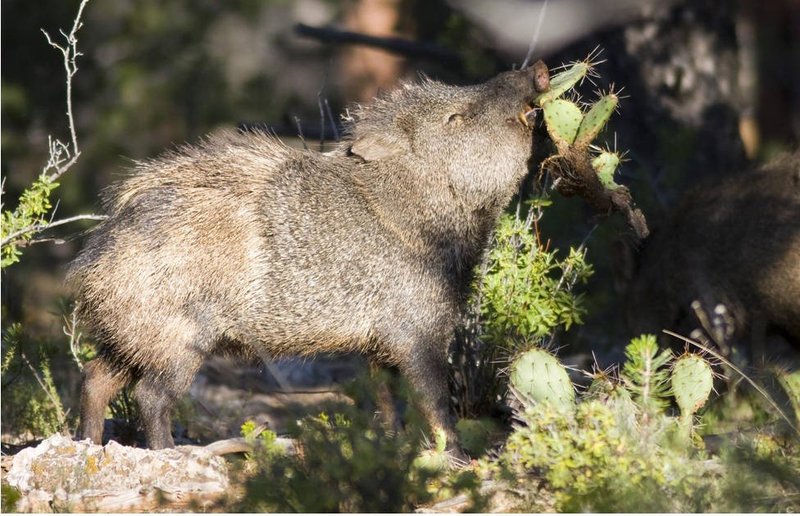
You might be scratching your head and wondering just what a javelina is. Well, these fascinating creatures are often mistaken for wild pigs, but they actually belong to a different family. Javelinas, or collared peccaries, are medium-sized mammals native to the Americas, primarily found in the southwestern United States, Mexico, and parts of Central and South America. Their unique appearance, social behavior, and ecological significance make them truly captivating.
Unlike domestic pigs, javelinas have a more slender body, long legs, and a distinctive collar of white fur around their necks. They have sharp teeth and sturdy hooves that help them forage for food in their natural habitat. If you’ve ever seen a javelina trotting about, you might have felt a mix of curiosity and admiration for these resilient animals.
In many ways, javelinas embody the spirit of the wild. They roam the desert landscapes, often in family groups, and their adaptive nature allows them to thrive in various environments. Whether you’re an animal enthusiast or just a curious mind, there’s so much more to learn about javelinas that goes beyond their cute snouts and social quirks.
Physical Characteristics of Javelinas
Javelinas have some distinctive features that set them apart from other wild animals. On average, they stand about 18 to 24 inches tall at the shoulder and can weigh between 44 and 90 pounds. Their fur is coarse and ranges from grayish-brown to black. One of their most notable features is the collar of white hair that encircles their neck, giving them their common name, “collared peccary.”
These fascinating creatures have sharp tusks that can grow to about one to two inches long. They use these tusks primarily for self-defense and foraging. Even though they may seem cute and cuddly, javelinas have a fierce side, especially if they feel threatened. Their keen sense of smell helps them detect food and potential predators, while their small, bright eyes offer good vision in low light.
Another interesting aspect is their adaptability in different environments. Javelinas have a robust body structure that allows them to thrive in dry, arid regions, as well as more lush, forested areas. This versatility not only makes them unique among their peers but also plays a significant role in the ecosystems where they live.
Habitat and Range
Javelinas are found in a variety of habitats, from arid deserts to tropical forests. You might spot them in grasslands, scrublands, and even rocky terrains. Their geographical range extends from the southwestern United States down through Mexico and into Central and South America. In the U.S., you can find them primarily in Arizona, New Mexico, and Texas.
One of the reasons javelinas can thrive in such diverse environments is their ability to adapt their behavior and diet according to what’s available. They often prefer areas with dense vegetation where they can find ample food and cover from predators. These areas provide the perfect blend of resources for their survival. It’s fascinating to think that a creature that looks so much like a pig can adapt so well to varying conditions.
As we consider their habitat, it’s important to acknowledge how human activities impact javelinas. Urban development and habitat destruction can threaten their populations. Conservation efforts are crucial to maintaining their habitats and ensuring these remarkable animals continue to thrive in the wild. So, next time you think about javelinas, remember the environments they call home and the challenges they face.
Diet and Feeding Habits
Now, let’s dig into what javelinas eat. These animals are considered omnivores, which means their diet consists of both plants and small animals. They particularly enjoy a range of fruits, nuts, roots, and seeds. For example, they often munch on prickly pear cactus pads and fruits, which are abundant in their habitats.
Javelinas have a remarkable ability to dig into the ground to reach tubers and roots, showcasing their adaptability when foraging for food. Their sharp tusks come in handy for this, allowing them to break through tough surfaces. Interestingly, they will also scavenge for insects and carrion when food is scarce, making them versatile eaters.
To give you an idea of their foraging behavior, javelinas often travel in groups. This social structure helps them find food more efficiently and provides safety in numbers. While they may not have the same reputation as other foragers, their collective efforts ensure that everyone gets their fair share. So, the next time you see a javelina, think of them as culinary adventurers exploring the flavors of their world!
Social Structure and Behavior
Javelinas are incredibly social animals, often seen in groups called “sounders.” These groups typically consist of 6 to 20 individuals, commonly composed of related females and their young. You might find it amusing to know that male javelinas are generally more solitary, leaving the group once they reach maturity. This communal living helps them stay safe from predators and allows for more efficient foraging.
The bonds within these groups are strong. Javelinas communicate through a range of vocalizations, body language, and even pheromones. You might hear soft grunts when they are content or harsh snorts when they feel threatened. They also engage in social grooming, reinforcing their bonds and promoting group cohesion. It’s like a little family gathering, filled with sniffs and cuddles!
Interestingly, javelinas have adapted to coexist with their environment and other species. They often share their habitats with larger animals, such as deer and coyotes, without much conflict. This coexistence showcases their resilient nature and ability to navigate the complexities of the animal kingdom. Observing their interactions can be a delightful reminder of the intricate web of life they weave together.
Reproduction and Lifespan
When it comes to reproduction, javelinas have a fascinating yet straightforward life cycle. They usually breed once a year, with the peak breeding season occurring during the late summer. After a gestation period of about 5 months, females give birth to typically one to four young, called piglets. These little ones are born with their eyes open and are able to walk shortly after arriving in the world.
The piglets are weaned at around 4 months old but will stay with their mother and the sounder for up to a year. The bond between mothers and their young is strong, with mothers offering protection and teaching vital survival skills. As they grow, the piglets become more independent, eventually venturing out on their own.
In the wild, javelinas can live up to 10 years, but many face dangers from predators or habitat loss that can shorten their lifespans. Factors like food availability and environmental challenges also play a significant role in how long they thrive. Understanding their reproductive cycle and lifespan helps us appreciate the delicate balance of nature and the challenges these amazing creatures face.
Conservation Status
The conservation status of javelinas varies across their range. Fortunately, they are not currently classified as endangered, and populations appear to be stable in many areas. However, habitat loss due to urban development and agriculture poses a significant threat. It’s crucial to recognize that maintaining healthy ecosystems is vital for their continued survival.
Conservation efforts have emerged to protect javelina habitats and educate the public about their importance in the ecosystem. By fostering a better understanding of these animals, we can work together to ensure they thrive for future generations. Whether it’s supporting local wildlife initiatives or simply spreading awareness, every little bit helps!
As we consider the future of javelinas, we must also remember our role in protecting their habitats. By taking care of the environment, we can ensure these charming animals and countless other species continue to flourish in the wild. Let’s embrace the responsibility we share in safeguarding their homes and keeping the ecological balance intact.
FAQ
Where can I find javelinas in the wild?
Javelinas are mostly found in the southwestern United States, particularly in Arizona, New Mexico, and Texas. They also inhabit parts of Mexico and Central and South America. If you’re hoping to spot one, consider visiting national parks or wildlife reserves in these areas where they thrive in natural habitats.
Are javelinas dangerous to humans?
Generally, javelinas are not aggressive towards humans. They tend to be shy and will usually run away if approached. However, if they feel threatened or cornered, they can defend themselves with their sharp tusks. It’s best to observe them from a distance and respect their space.
What do javelinas eat?
As omnivores, javelinas have a varied diet that includes fruits, nuts, roots, and seeds. They are known to eat prickly pear cactus, and they also forage for insects and carrion if needed. This adaptability in their diet is part of what helps them thrive in various environments.
How long do javelinas live?
In the wild, javelinas typically live up to 10 years, depending on environmental conditions and threats from predators. Some can live longer in protected areas, but many face risks that can shorten their lifespans.
Do javelinas have natural predators?
Yes, javelinas have several natural predators, including coyotes, mountain lions, and even larger birds of prey. Young javelinas are particularly vulnerable to these animals, which is why they rely on their family groups for protection.
How do javelinas communicate?
Javelinas communicate through a variety of vocalizations, physical gestures, and scents. They make soft grunts when content and loud snorts if they’re scared or feel threatened. Social behaviors like grooming also play a role in their interactions, helping to strengthen bonds within the group.
Are javelinas nocturnal?
Javelinas are primarily crepuscular, meaning they are most active during the early morning and late evening. However, they can also be seen during the day, particularly in cooler weather, as they search for food and socialize with their group.
Can javelinas be kept as pets?
While some people may be tempted to keep javelinas as pets due to their unique appearance, it’s important to note that they are wild animals. They have specific needs and behaviors that may not be compatible with domestic life. It’s best to enjoy them in their natural environments rather than trying to domesticate them.
What role do javelinas play in their ecosystem?
Javelinas play a significant role in their ecosystem as both herbivores and prey. By foraging for a variety of plants, they help in seed dispersal, contributing to plant diversity. As prey for larger predators, they also support the food chain, maintaining balance within their habitats.
Are there different types of javelinas?
Yes, there are several species of peccaries, but the collared peccary is the most commonly known as javelina. Other types include the white-lipped peccary and the Chacoan peccary, which vary in size, appearance, and habitat preferences. Each species has its unique adaptations to thrive in their respective environments.

